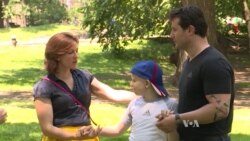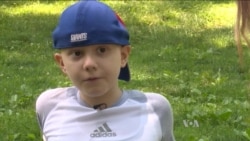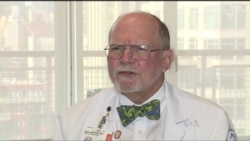In many ways, Gabriel is just like any other third grader. He does not like homework.
“I know homework is good for my brain and everything, but to me it’s pretty boring,” he said.
He likes videogames and football. For more than a year, though, this nine-year-old with a radiant smile has been fighting for his life.
“I am feeling good. Right now I just finished my last chemo. I just did my scans about a day ago, or yesterday, so whew [breathes deeply]. I finished my radiation, too. Now, my doctors are going to check out the scans that I did yesterday. If the scans are fine, than no more chemo. Yay!” he exclaimed.
WATCH: Gabe speak about how he is handling his challenges
When Gabe was diagnosed last year with a tumor in the brain, his parents were devastated.
“The sadness from the beautiful day, like today, right? Imagine, it starts pouring on you, darkness. It is so hard to adjust. Because we went from one extreme to the other,” his mother, Arjela Grada, said.
“My world just shattered, shattered, completely shattered,” added his dad, Bledar.
Arjela and Bledar Grada’s life transformed overnight. The news of cancer came just as they had started enjoying the fruits of their hard work as Albanian immigrants. They had arrived in the United States in 2000, young, and unable to speak English. Now they had good jobs, two healthy sons, and had just paid off the mortgage on their Brooklyn home.
They moved quickly after the diagnosis. After surgery, Gabe seemed to be doing better, but the biopsy results took a long time. They were eager to start treating the cancer. Then the results were in.
WATCH: Gabe's parents discuss how the family is coping
Extremely rare cancer
Paul A. Meyers, Gabe’s oncologist at Memorial Sloan Kettering Cancer Center in New York, said his case was important.
“Gabriel has an incredibly rare form of cancer, a tumor called desmoplastic small round cell tumor. This is a tumor that wasn’t even described until about 20 years ago,” he said. There are only 50 cases a year in the United States.
Gabe’s case also was important because until recently, tumors were recognized under the microscope. His was identified, however, by looking at the genetic information, a method that Meyers says has revolutionized the diagnosis and the treatment of childhood cancer.
“Desmoplastic small round cell tumor has almost never been described in the brain, and when you see a child with a tumor in the brain, you would think of a hundred things before you would ever think of this entity,” he said.
So next came chemotherapy and radiation. Gabe takes off his baseball cap to show his bald head.
“The hardest part for me? Chemo! It made me lose my hair, it made me have weird symptoms and especially this one: After the chemo, like a few days later, I would have to come back to the hospital because I usually have fever,” he said.
WATCH: Oncologist Paul A. Meyers talk about the treatment
Blog shines spotlight
Gabriel’s story — as well as those of other pediatric cancer patients, their parents, and the staff at Memorial Sloan Kettering Cancer Center — came under the spotlight in a series of posts on the popular Facebook page and blog Humans of New York, written by Brandon Stanton.
“A lot of these diseases are hard as it is, but to bring a face of a child to the name of these diseases [is] unbelievable and I feel blessed that we were part of it, so happy that we were able to raise the money that he raised. I am absolutely proud to be part of it,” said Arjela.
The blog's readers donated $3.8 million for pediatric cancer research for Sloan Kettering.
Not only is Gabe participating in fundraisers, but he also has advice for children undergoing treatment.
“Count down from 30, or any number you want, slowly and then after that, you calm yourself down, you just do in your mind one, two, three and then at three, you just tell the nurse: Do it! And you do the needle, it’s okay, everything is over, you did it,” he said.
Sharing the struggle
Arjela and Bledar say that when they came forward with their son’s story, they broke with cultural norms in Albanian communities.
“Coming from an Albanian family we never shared something like this, families that have had this, had gone alone. It’s a stigma,” Arjela said.
They wanted to show the importance of not becoming isolated, and they also wanted to reach out to other parents who face the same challenge.
She started to cry a bit as she recalled her lowest point. “I remember I couldn’t function, I couldn’t function even for my little one and it’s so hard, so hard. And I kept praying, I kept praying, I kept asking, I kept believing, it is going to be better. And after many months in the dark, I feel like spiritually I hit a corner and I started seeing light, I started seeing a better option for Gabriel.”
The answer for the family was to focus on joy.
“Make him happy. You got to enjoy, too, the same moments. You can cry at night. Because you got to cry. It’s not a weakness. But make sure your child does not see you," Bledar said.
“What we thought to do, was keep Gabriel laughing. We learned as we went that by keeping a positive side, you are able to deal with the negative that comes with it,” his mom observed.
These days, the Grada family has more reason to smile. They have gotten the news that Gabriel is now cancer free.
“I will smile for the rest of my life if I keep getting good news for Gabriel,” Arjela said.
And now Gabriel can return to life as a regular kid.











